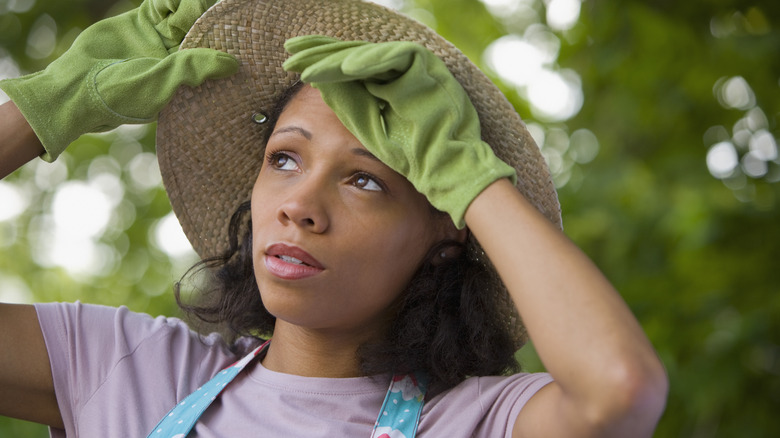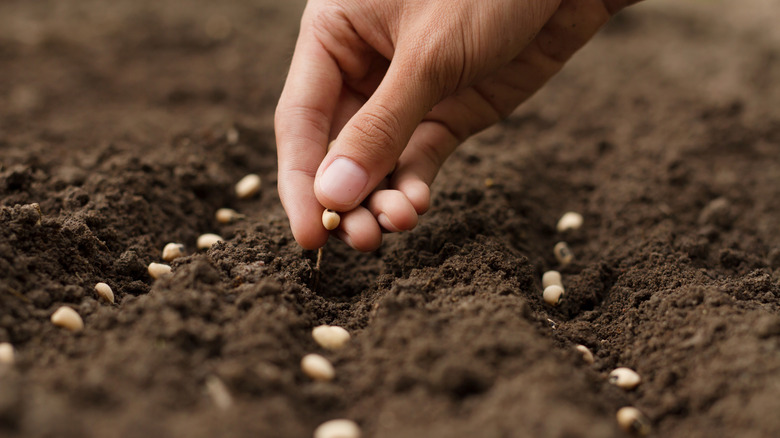The Hard Truth About Being A Beginner Gardener
Gardening is a favorite pastime for many people, and consumer interest in the activity just keeps growing. From growing healthy food to fighting stress by spending more time in nature, gardening has gained many new fans in recent years. But like any new hobby, it can take some time to learn the ropes. A Home Advisor survey found that the average gardener lost up to 35% of their plants in a year and that for beginners, that figure was up to twice as high. But there's good news: even though some plants may die while you're learning, gardeners who stick with it get better at keeping plants alive.
Gardening is a constant learning experience, with so much to keep track of: how to improve soil, choosing the right plants for your location and climate, fighting pests and diseases, and so on. Then there are principles of design to learn, along with knowing how tall certain plants will get and what season some flowers bloom in. Gardening also takes place over a season, and the lessons of spring are different from the lessons of summer, fall, and winter.
Some gardeners may find it frustrating at first to deal with failure in the form of dying plants until they learn the best ways to keep them thriving. But one of the best things about gardening is how it makes us aware of the natural cycles and seasons of nature, from spring's first signs of growth to autumn's first signs of decay.
Lessons from the growth cycles of plants
Each plant has a life cycle: for some it's a few weeks, for others, like bristlecone pine trees, it's hundreds of years. Whether you are growing perennials or annuals in your garden (or both), you can learn by observing the changes in their life cycles through the seasons.
The renewability of a plant during its life cycle is something that can be affected by human behavior. Pruning, trimming, and deadheading can stimulate growth: trimming off basil blowers, for example, forces your basil plants to devote more energy to producing larger leaves: the edible part of the plant. Paying attention to how plants behave as you water them, clear weeds, or add fertilizer also gives you clues to their care. Some plants are easily grown from seed while others require extra nurturing or special techniques. One way to gain confidence as a gardener is to start with plants that are easy to grow.
You can familiarize yourself with easy-to-grow "beginner" plants by checking catalog descriptions, reading plant nursery labels and tags, and also by consulting nursery employees, other gardeners, or gardening books and websites. Start with easy perennials like daylilies, columbines, or irises, which provide beautiful flowers with little care. Plant low-maintenance spring-blooming bulbs that increase each year (like daffodils or hyacinths). Or try easy-to-grow veggies in containers from seed, like lettuce or kale. This helps build your gardening confidence, one success story at a time.
Lessons of the gardening season
The gardening season begins in spring, as the days grow longer, the sun grows brighter, and the soil warms up after a season of snow and frost. In summer, the sun's heat and light, as well as rainstorms, provide what plants need to grow. Then the season winds down in autumn, after harvest, ending as the cold and darkness of winter turn plants dormant. This phenomenon is not just nature in action, it's a powerful metaphor for the human condition.
Perhaps that's why deadheading plants feels like both an ending and a beginning. The dead plant material makes way for new growth. Knowing that a plant goes through a dormant "dead" phase every year makes it easy to see that a "dead" plant is merely part of that eternal cycle. Dead plants and animals provide nutrients to the soil, which is the basis of all plant life. Gardening is an ongoing way to engage with this simple process of the natural world.
Gardeners should never be discouraged by plants dying. It's all part of the cycle of growth, not just of plants, but of our own learning. Many gardeners enjoy the activity not just for its practical benefits (food, shade, exercise, a beautiful home, helping pollinators, erosion control, etc.) but for the way it increases our awareness of our connection to the natural world. In time, if you stick with it, you will start to see every gardening endeavor as part of that journey.


